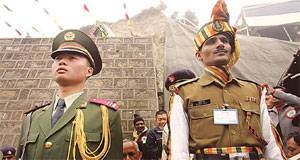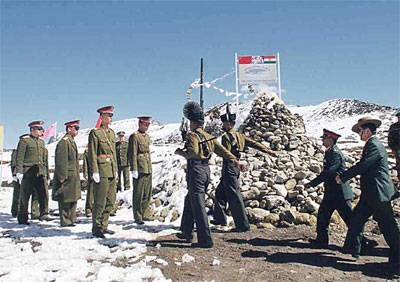War is around the corner
The situation on top of the world abruptly deteriorated in a matter of days. The parties to the conflict began to force troops, the Chinese and Indian soldiers retaliated with physical forces in several clashes. Not satisfied with the hand-to-hand, the parties managed to exchange small-arms fire weapons and artillery shelling. True, the collision did without significant casualties. And rather, they served as a demonstration that Beijing and New Delhi are not going to retreat.
The clash of the two nuclear powers on the Doklam plateau caused a wave of different expert opinions and analyst reports. But they all limited themselves to thinking about how far India and China will go in confrontation. At the same time, the military aspects of the confrontation remained out of discussion. Which side of the conflict is more prepared for war in the conditions of the Tibetan Highlands, where the average height is almost 5 kilometers? What is the strength and weakness of the participants in the confrontation? What weapons do Chinese and Indian military have? Let's try to answer these questions.
Indian "cotton"
New Delhi traditionally pays great attention to the war in the mountains. Moreover, the Indian military has a unique experience of full-scale combat operations at heights of from three to five thousand meters. Speech about the conflict with Pakistan in Kargil. In May – July, the 1999-th Indian Armed Forces recaptured the alpine posts occupied by the enemy in the disputed territory. A short but bloody war cost New Delhi nearly 600 dead and a thousand and a half wounded. Several airplanes and helicopters were lost.
 For action in the Himalayas, the Indian Defense Ministry has several mountain rifle divisions, as well as separate brigades. Airborne troops are also trained. But the experience of combined-arms battles in the mountains in the Indian military is small. The main task of mountain rifle units and subunits is to keep watch at numerous posts and patrol passes, as well as disputed territories.
For action in the Himalayas, the Indian Defense Ministry has several mountain rifle divisions, as well as separate brigades. Airborne troops are also trained. But the experience of combined-arms battles in the mountains in the Indian military is small. The main task of mountain rifle units and subunits is to keep watch at numerous posts and patrol passes, as well as disputed territories.Leave much to be desired uniforms, small arms and special equipment of Indian mountain shooters. In fact, all these critical elements remained at the level of 1980-x. Indian military can only dream of multi-layered sets of clothes for difficult weather conditions and tracking shoes. In their arsenal there are no special mountain backpacks and unloading vests. The main element of the mountain form of the Indian military is a long jacket park. As a heater the analog of cotton wool acts. Insulated headgear often serve as pagri turbans. Only a few units have special climbing equipment: strapping, mountain hammers, ice axes, etc. Body armor and ballistic helmets are a rarity.
Exercises on the conduct of the offensive, on the seizure of passes, passages and other important areas of the terrain are almost not conducted. And if organized, it is not above the link of the company-platoon. This is largely due to the special service schedule of the Indian mountain shooters. Part of the spring, in summer and autumn, they serve at roadblocks and observation points high in the mountains in disputed territories. At the same time, the garrisons rarely outnumber the platoon or even the squad. After a favorable period, servicemen leave their posts and descend. To organize combat training in such conditions is quite difficult.
According to the military-political leadership of India, the main tool of the mountain war is artillery. Therefore, New Delhi pays great attention to the purchase of powerful and mobile guns capable of firing at altitudes above three thousand meters. Thus, the victory over the Pakistani troops in Kargil won largely thanks to the Swedish howitzers FH77. Their 155-mm shells systematically swept enemy positions on passes and tops. And only then the mountain infantry went into battle. The Indian armed forces have 410 such artillery systems. Not so long ago, New Delhi signed a contract for the purchase of BAN Systems' 145 777 howitzer.
In contrast to the infantry Indian artillerymen constantly conduct exercises in the mountains. Not only shooting is organized. The transfer of howitzers, their deployment on the tops of the mountains are being worked out. Shooting is conducted in difficult conditions and in bad weather.
Chinese armor
China does not have specialized mining units. The national armed forces have infantry, motorized and tank shelves that are located in highlands. Including in Tibet, which borders with Bhutan and goes to the Doklam plateau.
 Compared to New Delhi, Beijing doesn’t have many disputed high mountainous areas that need to be protected. Their patrols are entrusted to border forces. At the same time, the mountain Chinese combined units are undergoing a full-fledged combat training course. It includes all the necessary elements, ranging from the coordination of offices and ending with the regimental and brigade exercises.
Compared to New Delhi, Beijing doesn’t have many disputed high mountainous areas that need to be protected. Their patrols are entrusted to border forces. At the same time, the mountain Chinese combined units are undergoing a full-fledged combat training course. It includes all the necessary elements, ranging from the coordination of offices and ending with the regimental and brigade exercises.The leadership of the Chinese Ministry of Defense believes that with proper organization, it is possible to conduct military operations in the mountains, using the same tactical techniques as on the plain. China is actively experimenting with the use of armored vehicles. In particular, a special mountain tank was created and put into service. Its exact name and tactical and technical characteristics are unknown. According to reports, the crew of a combat vehicle armed with an 105-mm cannon is three people. According to unverified information, in the near future, the Chinese mountain infantry will be replenished with specialized armored personnel carriers, infantry fighting vehicles and self-propelled howitzers.
Unlike the Indian Armed Forces, the PLA has first-class mountain ammunition and light weapons. The set of Chinese infantryman in Tibet includes multi-layered clothing, special backpacks and unloading vests. They also have lightweight “bronics” with modern ballistic helmets.
On photos from the Doklam plateau, the Indian military looks very poorly equipped against the background of the Chinese. And they clearly do not pull on the representatives of the power possessing nuclear weapons.
Why does not China strive to form special mining units and subunits, but it relies on combined-arms units equipped with special equipment? The answer is quite simple. The most important for Beijing high mountainous terrain - Tibet. With proper training and equipment, full-scale combined arms battles can be conducted using artillery and armored vehicles. The continuation of Tibet is the Plateau Plateau, where, according to the Chinese concept, it is also possible to use combined-arms units.
Roads and rear
The main condition for victory in a high mountain war is the timely supply of troops. This lesson is well learned in India. Therefore, New Delhi is paying close attention to the organization of logistics in high altitude conditions. The experience of the war in Kargil showed that the most effective way is an air bridge.
In May – July 1999, the Indian Air Force was able to provide uninterrupted supply to its highland group. An-32 aircraft delivered cargo to high-altitude airfields, from there the property was transported by helicopters to supply points on mountain peaks and passes. Now to increase lifting capacity aviation in the mountains New Delhi buys US military transport aircraft S-17.
Air operations experience is useful to India in Bhutan. There are no high-capacity normal roads to the Doklam plateau. Therefore, if an Indian division or several brigades are deployed there, their supply will fall on the shoulders of the air force. But there are no normal airfields in Bhutan either. Therefore, it is necessary to build temporary runways.
However, the air bridge in Kargil proved effective only because it was not opposed by Pakistani fighters and air defense weapons. But in the case of the PRC and the Plateau Plateau, New Delhi can hardly count on such pacifism. The Chinese military will make every effort to isolate the Indian contingent from supplies. In the course will go fighter jets, which will be engaged in the interception of transport aircraft and helicopters. And fighter-bombers, missile systems and artillery will begin to strike at temporary Indian runways.
Despite the clearly brewing conflict and partnership with Bhutan, New Delhi did not pay attention to the early preparation of a potential theater of war. And Beijing launched a full-scale construction in Tibet.
The Chinese military has at its disposal a unique railway that leads from the flat part of China to the capital of Tibet, Lhasa. Recent photos have shown that this transport artery is actively used by the military of the Middle Kingdom for the transfer of troops.
As you know, there are several empty stations on the railway in Tibet. They are equipped with a full set of equipment and even aprons and special turnstiles for passengers. But they are very far from settlements. In the event of a conflict, these stations will become home bases for air defense units covering the strategically important highway. You can also place repair teams for emergency restoration of the web and bridges.
In Tibet, there are several airfields. For example, located at a distance of 60 kilometers from Lhasa, a first-class Gonggar. The air harbor has a runway length of 4000 meters. It is quite suitable not only for take-off and landing of fighters, but also for IL-76 transport aircraft.
Staff work
India has a unique experience of high mountain war, but it is of little use in the case of large-scale battles on the Doklam plateau. It will be difficult for the common army units of the Indian army to fight at heights above 4000 meters. And the specialized mountain arrows will be too weak against the Chinese mountain motorized infantry and armored units. Military Celestial certain problem can create Indian artillery. True, its effectiveness will depend on the operation of the air bridge between the plateau and the “Big Earth”. Indian headquarters do not have to rely on the passage of automobile columns in the conditions of the underdeveloped road network of Bhutan.
Unlike New Delhi, Beijing has been building military infrastructure in Tibet for decades. In addition to the deployment there of special military units intended for action in the region, China led to this high-mountainous region full-fledged transport arteries. The infrastructure is constantly being improved, the PLA military are well prepared for combat operations in unique geographic conditions.
Moreover, it was precisely road activity that was the reason for the current armed conflict. Chinese military engineers began working on the Doklam area, conducting surveys to build a road from Lhasa towards Bhutan. How can this threaten India? The fact is that with the ability to transfer military contingents to a plateau, China will be able to fully threaten the strategically vulnerable region of India - the narrow isthmus between Nepal and Bangladesh, which connects the main territory of the country with several eastern states. Because the Indian troops immediately showed activity, trying to oust the Chinese units from the plateau.
Information